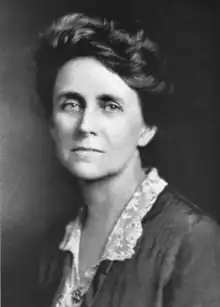Viola Ross Napier | |
|---|---|
 | |
| Member of the Georgia House of Representatives | |
| In office 1923–1926 | |
| Personal details | |
| Born | Viola Ross February 14, 1881 Macon, Georgia, U.S. |
| Died | June 27, 1962 (aged 81) |
| Spouse | Hendley V. Napier Jr. |
| Children | 4 |
| Alma mater | Wesleyan College |
| Occupation | lawyer |
Viola Ross Napier (1881–1962) was one of the first two women, along with Bessie Kempton, to be elected into the House of Representatives in the U.S. state of Georgia following the passage of the 19th Amendment to the U.S. Constitution which gave women the right to vote. Napier was also the first female lawyer to argue in front of the Georgia Court of Appeals and the Georgia Supreme Court.[1] In 1993 she was posthumously inducted into the Georgia Women of Achievement.
Early life
Viola Felton Ross was born in Macon, Georgia on February 14, 1881. Her grandfather from her mother's side was one of the city's founders. After graduating in 1901 from Wesleyan College,[2] she became a schoolteacher. During her teaching career she met and married a lawyer, Hendley Napier Jr., in 1907. They had four children together. Shortly after, her husband died as a result of the flu epidemic of 1919. After losing both her husband and father-in-law, she decided to go back to school; she attended Judge "Lije" Maynard's night school in Macon, studying to become a lawyer.[3]
Legislature life
It was uncommon for women in the early 1900s to become lawyers, and Napier found it difficult to obtain a job. She decided to open her own practice. She became the first female lawyer to argue in front of both the Georgia Court of Appeals and the Georgia Supreme Court. She also became the first woman to win a pardon for a convicted client before the client served any of his sentence.
After the approval of the 19th Amendment in 1920, which allowed women to vote, Napier was convinced by the editor of the Macon News to run for General Assembly and hence became one of the first two women to be welcomed into the House of Representatives in Georgia. During her time in the Georgia General Assembly, she introduced several bills that were sponsored by the League of Women Voters, an organization that encouraged women to use their new power to participate in shaping public policy.[4] The bills included compulsory education legislation, child labor legislation, and the legislative recommendations of the Children's Code Commission. She secured adoption of laws requiring better fire protection in orphanages, schools and children's hospitals. She also sponsored a bill to improve education for the blind, the handicapped, and the underprivileged, and introduced a bill to prevent child labor.
Napier remained in the House of Representatives for a second term and was defeated when she ran for a third term.
A collection of her papers are held at the Middle Georgia Archives in the Washington Memorial Library in Macon.[5]
References
- ↑ Carpenter, Cathy. "Viola Ross Napier". georgiaencyclopedia.org. Retrieved 18 December 2014.
- ↑ "Viola Ross Napier Class of 1901". wesleyancollege.com. Archived from the original on March 4, 2016. Retrieved 18 December 2014.
- ↑ "Napier, Viola Ross". Georgia Women of Achievement. Retrieved 18 December 2014.
- ↑ Schuyler, Lorraine Gates (2008). Weight of Their Votes: Southern Women and Political Leverage in the 1920s: Southern Women and Political Leverage in The 1920s (illustrated ed.). Univ of North Carolina Press, 2008. p. 159. ISBN 9780807876695. Retrieved 18 December 2014.
- ↑ Napier, Viola Ross, Viola Ross Napier papers, 1898-1993, OCLC 38476122,
The collection consists of papers of Viola Ross Napier from 1898-1993. The papers include correspondence, legal documents, legislative records, newspaper clippings, and photographs. The materials mainly document Napier's law practice and legislative service. Part of the correspondence (1978-1993) relates to recognition of Napier's civic and political contributions by various organizations and agencies.